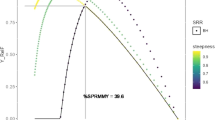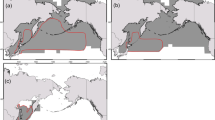Abstract
This paper examines the relationship between red cod, Pseudophycis bachus, recruitment and selected environmental variables. Commercial catch data of red cod were used as indices of relative recruitment strength for New Zealand fish stocks (east coast South Island, RCO 3; west coast South Island, RCO 7). Analysis of catch per unit effort (CPUE) supports the assumption that fluctuations in commercial catches reflect changes in abundance resulting from variable recruitment. Catch was assessed against 34 environmental variables that included the Southern Oscillation index, sea surface temperature, weather types, wind speed and direction, and river flows. Lagged correlations were calculated between annual commercial catch and averaged environmental data. Variables most strongly correlated with commercial catch were included in regression analyses. Regression models were calculated using all available data in its raw form, and after application of a logarithmic transformation. Robustness, and forecast skill was tested using a repeated leave-one-out procedure. The strongest correlations between commercial catch and explanatory variables for both RCO 3 and RCO 7 were consistently with sea surface temperature over a wide range of time lags followed by frequencies of southwest and northeast flow patterns. The correlations generally operated in the sense that ‘colder is better’: negative correlations (∼−0.75) with sea surface temperature, positive with the occurrence of cool southwest weather types, negative with the occurrence of warm northeast weather types. The maximum magnitude of the correlation occurs at 14-month lag for both fisheries, corresponding to the late spring/summer of the year prior to the catch year. There were often secondary maxima in the magnitude of the correlations two or three years prior to the catch year. The commercial fishery is made up largely of two and three-year-old fish, implying that juvenile fish (age ∼ one year) are most sensitive to environmental conditions, but egg, embryo and larva periods may also be affected. Regression analyses suggest that two-predictor regressions were unstable, with often large decreases in explained variance when applied to the independent years, however, at the lags when relationships are strongest (around 14 months), the explained variance on the left-out years remains high. Fluctuations in red cod landings are dependent on sea surface temperature, controlled largely by climatic variability, including El Niño and La Niña events. For short-lived species such as red cod, fluctuations in annual landings are commonplace and analyses of environmental data may be useful in predicting catches in subsequent years.
Similar content being viewed by others
References
Box, G.E.P. & G.M. Jenkins. 1976. Time series analysis: forecasting and control. Holden-Day series in time series analysis. Holden-Day, San Francisco. 575 pp.
Chiswell, S.M. 1996. Variability in the Southland Current, New Zealand. N. Z. J. Mar. Freshw. Res. 30: 1–17.
Drinkwater, K.F. & R.A. Myers. 1987. Testing predictions of marine fish and shellfish landings from environmental variables. Can. J. Fish. Aquat. Sci. 44: 1568–1573.
Francis, M.P. 1993. Does water temperature determine year class strength in New Zealand snapper (Pagrus auratus, Sparidae)? Fish. Oceanogr. 2: 65–75.
Frank, K.T. 1991. Predicting recruitment variation from year class specific vertebral counts: an analysis of the potential and a plan for verification. Can. J. Fish. Aquat. Sci. 48: 1350–1357.
Gordon, N.D. 1986: The Southern Oscillation and New Zealand weather. Mon. Weather Rev. 114: 371–387.
Greig, M.J., N.M. Ridgway & B.S. Shakespeare. 1988. Sea surface temperature variations at coastal sites around New Zealand. N. Z. J. Mar. Freshw. Res. 22: 391–400.
Habib, G. 1975. Aspects of biology of red cod (Pseudophycis bachus). Ph.D. Thesis, University of Canterbury, Christchurch. 203 pp.
Heath, R.A. 1971. Hydrology and circulation in central and southern Cook Strait, New Zealand - 1982. N. Z. J. Mar. Freshw. Res. 5: 178–179.
Heath, R.A. 1985. A review of the physical oceanography of the seas around New Zealand - 1982. N. Z. J. Mar. Freshw. Res. 19: 79–124.
Heath, R.A. & A.E. Gilmour. 1987. Flow and hydrological variability in the Kahurangi Plume off north-west South Island, New Zealand. N. Z. J. Mar. Freshw. Res. 21: 125–140.
Helbig, J., G. Mertz & P. Pepin. 1992. Environmental influences on the recruitment ofNewFoundland/Labrador cod. Fish. Oceanogr. 1: 39–56.
Horn, P.L. 1996. Age and growth of red cod (Pseudophycis bachus) off the south-east coast of South Island, New Zealand. N. Z. J. Mar. Freshw. Res. 30: 151–160.
Houde, E.D. 1997. Patterns and consequences of selective processes in teleost early life histories. pp. 173–196. In: R.C. Chambers & E.A. Trippel (ed.) Early Life History and Recruitment in Fish Populations, Chapman & Hall, London.
Jolliffe, I.T. 1986. Principal component analysis. Springer-Verlag, New York. 271 pp.
Karoly, D.J. & D.G. Vincent. 1998. Meteorology of the Southern Hemisphere. In: Meteorological Monographs, American Meteorological Society, Boston. 410 pp.
Kidson, J.W. & N.D. Gordon. 1986. Interannual variations in New Zealand temperature and precipitation patterns. N. Z. J. Geol. Geophys. 29: 363–375.
Kidson, J.W. 2000. An analysis of New Zealand synoptic types and their use in defining weather regimes. Int. J. Climatol. 20: 299–316.
Longhurst, A. 1998. Ecological geography of the sea. Academic Press, London. 398 pp.
Mantua, N.J., S.R. Hare, Y. Zhang, J.M. Wallace & R.C. Francis. 1997. A Pacific interdecadal climate oscillation with impacts on salmon production. Bull. Amer. Meteor. Soc. 78: 1069–1079.
Mullan, A.B. 1998. Southern Hemisphere sea surface temperatures and their contemporary and lag association with New Zealand temperature and precipitation. Int. J. Climatol. 18: 817–840.
Pepin, P. 1991. Effect of temperature and size on development, mortality, and survival rates of the pelagic early life history stages of marine fish. Can. J. Fish. Aquat. Sci. 48: 503–518.
Power, S., T. Casey, C. Folland, A. Colman & V. Mehta. 1999. Inter-decadal modulation of the impact of ENSO on Australia. Clim. Dyn. 15: 319–324.
Rayner, N.A. 1999. SST and sea-ice fields for ERA-40, in proceedings of Second International Conference on Reanalyses, WMO/WCRP, Reading. 22 pp.
Renwick, J.A., R.J. Hurst & J.W. Kidson. 1998. Climatic influences on the recruitment of southern gemfish (Rexea solandri, Gempylidae) in New Zealand waters. Int. J. Climatol. 18: 1655–1667.
Shepherd, J.G., J.G. Pope & R.D. Cousens. 1984. Variations in fish stocks and hypotheses concerning their links with climate. Rapp. P. V. Reun. Cons. Perm. Int. Explor. Mer. 185: 255–267.
Stanton, B.R. 1976. Circulation and hydrology off the west coast of the South Island, New Zealand. N. Z. J. Mar. Freshw. Res. 10: 445–467.
Sturman, A.P. & N.J. Tapper. 1996. The weather and climate of Australia and New Zealand. Oxford University Press, Oxford. 476 pp.
Trippel, E.A. & R.C. Chambers. 1997. The early life history of fishes and its role in recruitment processes. pp. xxi–xxxii. In: R.C. Chambers & E.A. Trippel (ed.) Early Life History and Recruitment in Fish Populations, Chapman & Hall, London.
Tyler, A.V. 1992. A context for recruitment correlations: why fisheries biologists should still look for them. Fish. Oceanogr. 1: 97–107.
Walters, C.J. & J.S. Collie 1988. Is research on environmental factors useful to fisheries management? Can. J. Fish. Aquat. Sci. 45: 1848–1854.
Author information
Authors and Affiliations
Rights and permissions
About this article
Cite this article
Beentjes, M.P., Renwick, J.A. The Relationship between Red Cod, Pseudophycis Bachus, Recruitment and Environmental Variables in New Zealand. Environmental Biology of Fishes 61, 315–328 (2001). https://doi.org/10.1023/A:1010943906264
Issue Date:
DOI: https://doi.org/10.1023/A:1010943906264




